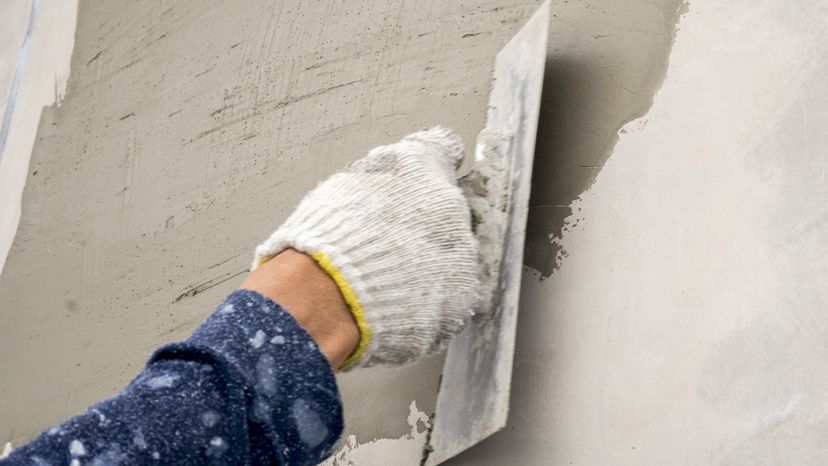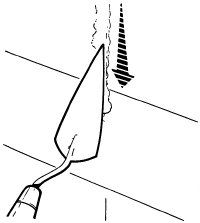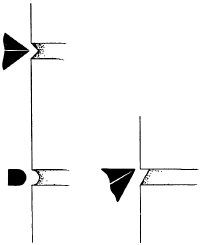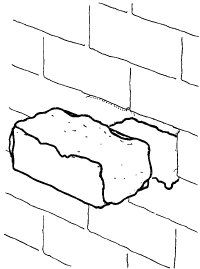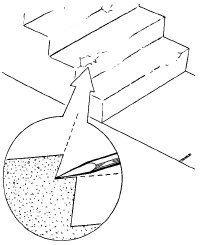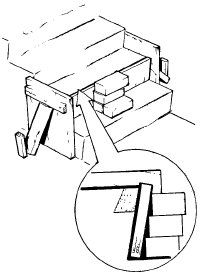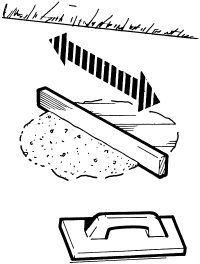Unless there's a serious structural problem, wide, top-to-bottom cracks in brick or concrete-block walls are easy to fill. And there's no need to be obsessed with perfection. Work through the broken bricks instead of trying to replace them.
Tools:
- safety goggles
- cold chisel
- sledgehammer
- brick chisel
- wire brush
- garden hose
- mixing bucket and stir stick
- small sharp trowel
- wide board to cover crack
- 2 × 4 prop
- large funnel
- rubber tubing to fit over funnel end
- mortar jointer or thin metal rod
- paintbrush
Materials:
- mortar mix
- Portland cement
- hydrated lime
- sand
- scrap corrugated cardboard
- mortar coloring
- duct tape
- exterior paint or cement paint
- solvent for paint
Time: about 3 to 4 hours for cleaning and initial filling; additional time depending on extent of damageWearing safety goggles, begin by cleaning all crumbling brick and mortar from the crack with a cold chisel and sledgehammer. Where the crack runs through a brick or a concrete block, use a brick chisel, angled into the crack, to widen and undercut the break. Enlarge the crack to a consistent width and clean the inside of the crack to its full depth, or as far in as you can reach. Wire-brush the crack, inside and out, to remove debris, then flush it thoroughly with water from a garden hose.Cracks that affect only a single layer of brick can be filled with mortar. Mix a small amount of mortar according to the directions on the package. Spread a little mortar on a scrap of corrugated cardboard, where it will dry quickly and reveal its true color. Add mortar coloring to the mortar as necessary to match the old mortar, experimenting with the cardboard as you add coloring. When the dried test batch matches the old mortar, mix enough mortar to fill the crack and add coloring in the tested proportion.Spray the crack thoroughly with the garden hose. Fill the crack with mortar using a small, sharp trowel to force the mortar into the full depth of the crack. Treat the crack as one long joint, filling cleaned-out joints and the gaps in broken bricks or concrete block evenly all along the crack.When the crack is solidly packed with mortar, finish the surface with a jointer and the trowel. Match the old joints where the crack follows a joint: trowel the mortar to match the surface where the mended surface is block or brick. Let the crack cure thoroughly for at least 1 week. Spray the patched area lightly with the garden hose several times a day during the curing period.When the crack is very wide and deep, fill it with a thin grout mixture. Wearing safety goggles, chisel out, wire-brush, and flush the crack with water to clean it thoroughly. Mix a small amount of filler, using 1 part Portland cement,1 part hydrated lime, and 6 parts sand. Mix the dry materials and add water slowly to form a thin, easily pourable grout. Add mortar coloring, testing the mixture on a scrap of corrugated cardboard, to match the color of the old mortar; then mix a bucketful of grout in the same proportions.Working quickly, spray the inside of the crack lightly to dampen it. Mask the lower third of the crack with duct tape set flat over the opening. Set a wide board flat against the wall to hold the tape in place, and wedge it firmly upright with a 2 × 4.
Use a wide-mouthed funnel and a length of rubber tubing to fill the crack; you'll need a helper for this. Push one end of the tubing over the narrow end of the funnel and set the open end into the crack. Hold the end of the tubing at least halfway into the crack and as near the bottom as you can reach over the board wedged against the wall. Pour grout slowly into the funnel to fill the bottom of the crack. Then remove the tubing from the crack. Rinse the funnel, the tubing, and the bucket thoroughly.
Let the partially filled crack set for about 1 day. Then remove the board and the duct tape from the crack. Use a mortar jointer -- or thin metal rod bent to form a handle -- and a trowel to finish the crack, matching both joint and brick or concrete block textures. Then fill the crack further.
Mix a bucketful of grout in the same proportions as before. Working quickly, spray the crack lightly with a garden hose. Mask the crack with duct tape and wedge the board back into place against the wall. Using the wide-mouthed funnel, pour the grout into the crack as before. Let it dry for 1 day and remove the mask; finish the grout to match joints and brick or block.
Repeat the filling and finishing process daily, section by section, until the entire crack has been filled. Be sure to mix and color the grout in the same proportion each time. Let the grout cure thoroughly for at least a week after the final application of grout. Spray the patched area lightly with the garden hose several times a day during the curing period.
Finish either mortar-filled or grout-filled cracks by painting the patch to match the surrounding wall. For a painted wall, touch up the newly filled and cured crack with the same exterior paint used on the wall. To hide the crack in a brick wall, use cement paint the same color as the bricks. Thin the paint and apply it carefully to the crack where it passes through bricks; repeat as necessary until the color is correct.
Continue to the next page to put your concrete skills to work on potholes in your driveway.
For further tips and instructions on how to fix things around the house:
- Home-Repair Safety Tips: Doing the job yourself doesn't save you money if you end up in the emergency room. Read these tips to make sure you work smart when doing home repairs.
- Home-Repair Tool Basics: Does your tool box have what it takes? Learn what tools you're likely to be looking for when making repairs around the house.
